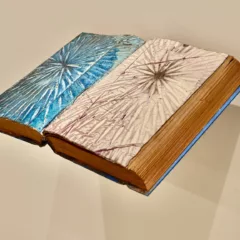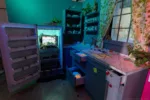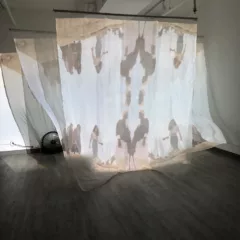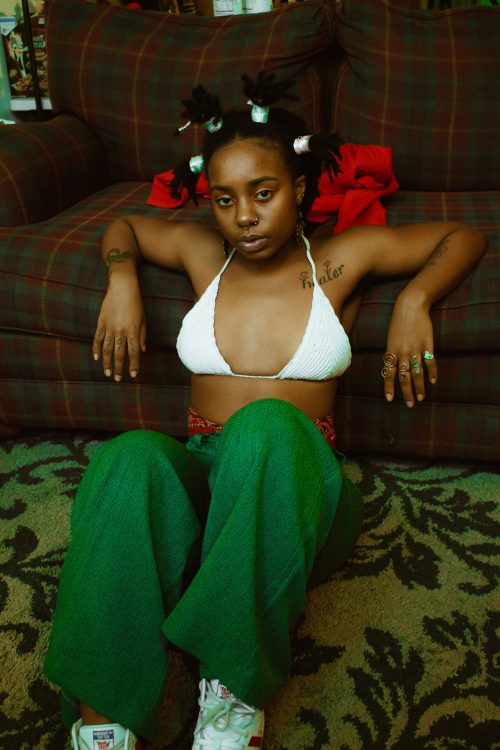
Black Trans Futuristic, Wit López’s sophomore curation at the William Way Center explores the expression of queer black, specifically queer and trans, identity, with six distinct Philadelphia artists. Recalling Afrofuturism, Lopez makes a conscious decision to choose artists — Jamie Grace Alexander, Wriply M. Bennet, Shanel Edwards, Devyn Farries, Myx Omiya Isa, and Essa Terick/Tahnee Jackson — that lean into outlier genres such as science fiction, magic, fantasy, in some ways also horror with Myx Omiya Isa’s work. Appropriately, these genres are world- building modes, both by transmuting internal realities into external ones or by inverting. More subtly, they also exclude more conventional and canonical mediums and styles such as classical or realist painting, sculpture, and photography in favor of animation, mixed-media collage, shrines, even fashion photography.
An exhibit of vulnerability, altars, and raw confessionalism
The exhibition’s effect is both of radical estrangement and a delicate intimacy. On the one hand, choosing to dismiss traditional art media, and claiming traditionally lowbrow aesthetics as queer and black abruptly disconnects from white, cis, and heteronormative values of ‘good art’ and forces the viewer to confront how they value and contextualize art in implicitly political ways. On the other hand, the aesthetics and tone of the show recall early art community websites such as Tumblr, DeviantART, and LiveJournal. While flawed, these online forums married the diary with a virtual gallery, for deeply idiomatic art, which created a safe space for many femme and queer artists. Anyone who grew up in the ‘00s and participated in these communities — as I did—will sense a similar vulnerability and raw confessionalism from this exhibition. Many works are not for sale.
While the architecture of the William Way’s lobby provides symmetry and formality to the pithy exhibition, the works are juxtaposed to highlight their disparateness and individualism, challenging a complacent notion of a homogenous ‘black trans’ aesthetic. Essa Terick’s work most aptly captures the magical dimension of transformation, with two shrines involving tarot, mirrors, and more unusual spellcasting ingredients. At distance from one another, each shrine incorporates the four elements, with candles representing fire; shells and other aquatic debris, water; sage and crystals, earth; and music and reflected light collectively evoking air. Together they suggest alchemy, the magical distillation of one element into a physically unrelated other. The first shrine, “Past Futures” centers a tiny glass vial of testosterone before an imposing African mask and flanked by tarot cards of Strength and Power, a cassette of Prince’s Prince and the Revolution, and a bottle of “Florida Water” aftershave. Their second, sparer shrine, “Future Futures,” replaces the glass vial with a mirror and includes the cards of Love and Art. In the space between the two, Essa Terick seeks to represent the invisible quantity of transformation when one transitions. For the trans-masculine individual, external signifiers of masculinity (shaving, the sexual virility of the androgynous Prince, expressions of strength) transmute into spiritual harmony, self-love, and untethered creativity as their internal and external world mirror each other.
Jamie Grace Alexander’s “Contingency Altar” uses a similar conceit to very different effect. A purple portal mish-mashing media decidedly drawn from common craft supplies, like paint markers and glitter, the installation simulates a child’s fantastical imagination seeking to synthesize the fragmented queer identity. Doodles sketched in dots evolve into a galaxy as if the altar was a window looking out into space—in the center is a mirror scrawled with the word ‘portal.’ Like “Past Futures” and “Future Futures,” a viewer is invited into the process of psychological transformation—in this case, an interstellar, Afrofuturist fantasy where the confusing mundane categorizations of identity are shattered and dissolved off-planet, destined to eventually arrive, an understanding of personal identity: the mirror.
Stylized realism in drawings and paintings
Wriply M. Bennet and Devyn Farries represent drawing and painting in the show, but their works eschew realism in favor of comic book/anime and symbolist stylings. In a series of five, Bennet celebrates the black and brown body, the fat body, the tattooed and chimeric body, and the queer body. Cast with bold colors, sensual, lively gestures, and intense personality, these figures are often elevated above mere mortality, either as queered mermaids or as a deity. Present in four images, water occupies a central theme as a psychic emotional space that can prove either rejuvenating and life-giving as in the case with” Gasp” and “Bath Time,” or oppressive as with “Death of the Nameless Goddess.”
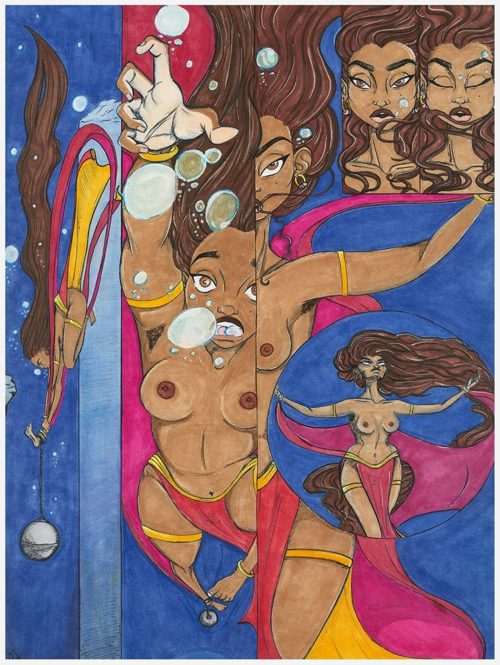
In contrast to Bennet’s vivacious sprawl, Farries’ formalist arrangement of four delicate watercolor paintings delves inwards for enigmatic portraiture. Like the holy trinity, three anonymous people surround a central figure in the one composition. Though with different bodies, these individuals share common traits, whether a mullet, a gauged ear, or a halo, imploding cis-gender boundaries to express a unified identity. Rising from a rainbow at the bottom of the frame, the vibrant “A Visage of Self” appears to be the core and apotheosis of all of these characters masculine, feminine and androgynous. The painting corresponds to the central circle in the sacred geometry that occurs not only as a motif in the images but in the actual formal gathering of the watercolors themselves. While theirs is the only face we can see, Farries still denies the (white, hetero-normative) viewer full knowledge of this Self. The figure’s eyes are closed, withdrawing from the audience while the other figures, back-turned, gaze into a divine unknown. Perhaps the mysterious “Red,” the other fully-colored image at the apex of the group, depicts the artist’s personal self-conception. Regardless, the works imagine queerness with a gravitas and a divinity it is often denied.
Installations with words, photos
The remaining artists Myx Omiya Isa and Shanel Edwards both choose photography and elaborate compositions in their contributions. Isa’s hallucinatory text and photo installations cite the constructive languages of spell work and code, to explore the existential and political struggle and resilience that underlie each moment for a non-cis body and the therapeutic potential of language. In the case of “The Rememberingness at the Edge of Knives//Our Knowing is in the Blood: Self Portraiture,” Isa hones in on the simple act of shaving. Typed documents link these gothic photos of a face dimly lit, covered in shaving cream, at times barely visible that hover between macabre and fantastical. The words are like protective sutures holding the identity of the artist together through dark confusion. Shanel Edwards’ photo collages are beautifully photographed but the vaguest in intent. Focusing on three black femmes in both intimate proximity and in urban and green environments. it’s unclear what the nature of their relationship, implied by strips of cellophane, actually is, and whether Edwards’s decision to use both monochrome and color images denote changes in the emotional state of their subjects. In the end, it is perhaps fruitless to read or analyze such personal images on such mutable and historically othered identities, which is a central riddle of Black Trans Futuristic. Art is an object to be seen; selfhood is an experience no one can demand.
Black Trans Futuristic is free admission and on view until February 22nd at the William Way Center, 1315 Spruce St.
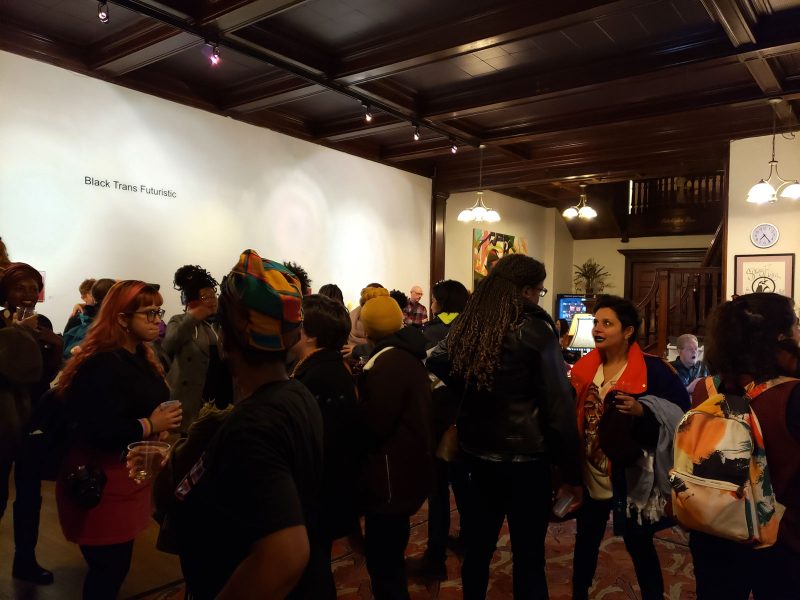
About the Curator, Wit López: Based in Philadelphia Wit López is a disabled gender non-conforming/nonbinary activist, artist, curator, and scholar. Of African American and Boricua heritage, their work analyzes the intersection of the marginalized identities they hold through performance, fiber arts, and mixed media. A Leeway Foundation grant recipient, they are a founder and director of the Till Arts Project and have worked with the William Way Center. Vox Populi Gallery, Icebox Project Space, and Space 1026. Black Trans Futuristic is their second show with the William Way Center; they previously exhibited there in the group show Dreams of You: Soft Touches and Fiber Futures (2018). [ED. NOTE: Wit is also an Artblog contributor. See their author page for more.]


